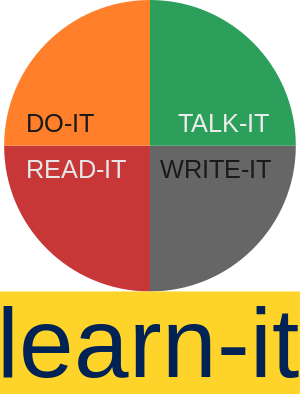 Iconic image for social science. (Photo credit: Wikipedia)Neil Ballantyne opened by giving an overview of blended learning, emphasising that it is not a lesser model than purely face-to-face. He then moved on to look at Social science knowledge (declarative knowledge - knowing about), clinical practice (knowing how), and which you might put online. He introduced the term technoscepticism, and indicated some articles such as "The failed promised of hypertechnology" (Kreuger & Stretch, 1999), and What is the role of hypertechnology (Kreuger & Stretch, 2000). These articles pull a "lot of stuff out of nowhere", and were written to support a point of view rather than to critique or discuss face-to-face and blended approaches.
Iconic image for social science. (Photo credit: Wikipedia)Neil Ballantyne opened by giving an overview of blended learning, emphasising that it is not a lesser model than purely face-to-face. He then moved on to look at Social science knowledge (declarative knowledge - knowing about), clinical practice (knowing how), and which you might put online. He introduced the term technoscepticism, and indicated some articles such as "The failed promised of hypertechnology" (Kreuger & Stretch, 1999), and What is the role of hypertechnology (Kreuger & Stretch, 2000). These articles pull a "lot of stuff out of nowhere", and were written to support a point of view rather than to critique or discuss face-to-face and blended approaches.Neil looked at distance education in social work and current and emerging trends (US Council survey of social work):
- 41% of BSW and 52% of MSW are delivering distance courses
- Further 18% of BSW and 19% of MSW are considering delivery
- 72% of BSW and 56%of MSW are using Internet/Web delivery
A comparison of on-campus and distance social work education (Olairio and Trotter, 2010):
- Different demographics
- Were studying like this because they had to (life circumstances)
- No significant difference in satisfaction or grades
- Slight difference in relation to some Fieldwork Educator ratings
 Method for learning and education. (Photo credit: Wikipedia)Learning practice skills are often being mediated even in face-to-face scenarios by technology. It is not unusual, especially where problem based approaches are used. Check out Ballantyne and Knowles (2007), "Enhancing student learning with case-based learing objects in a problem-based learning context: the views of social work students in Scotland and Canada (Journal of Online Learning and Teaching, Vol 3, pp. 363-374). There were no significant differences between the outcomes of the face-to-face and online...at which point it becomes significant. Online / distance learning is no longer the second cousin. Clinical skills can be taught online.
Method for learning and education. (Photo credit: Wikipedia)Learning practice skills are often being mediated even in face-to-face scenarios by technology. It is not unusual, especially where problem based approaches are used. Check out Ballantyne and Knowles (2007), "Enhancing student learning with case-based learing objects in a problem-based learning context: the views of social work students in Scotland and Canada (Journal of Online Learning and Teaching, Vol 3, pp. 363-374). There were no significant differences between the outcomes of the face-to-face and online...at which point it becomes significant. Online / distance learning is no longer the second cousin. Clinical skills can be taught online.Interaction...new kinds of interaction? What do we mean by interaction? There are interactions with content, tutors, other learners (the diagram by Anderson, T, 2006 is well worth having a look at). Communities of inquiry can underpin the design of online and blended learning experiences. Having the right learning experiences at the right time are problematic. So, what if you could have a virtual practicum. For one hour each week praticum students engage in an immersive VR simulation. They engage with real and simulated actors in key scenarios linked to learning outcomes. Difference cultures can be represented, and skills are practised and can be assessed. the avatars pass the Turing Tests. Would this be an educationally toxic experience?





No comments:
Post a Comment